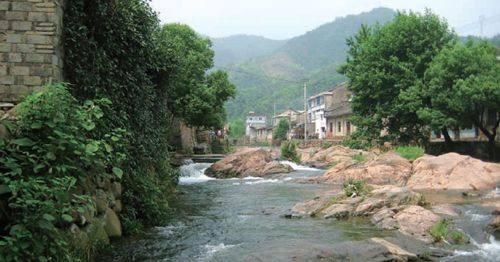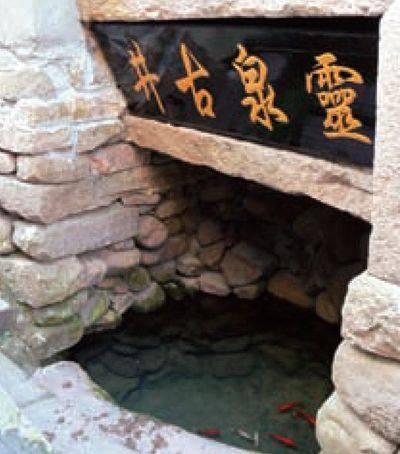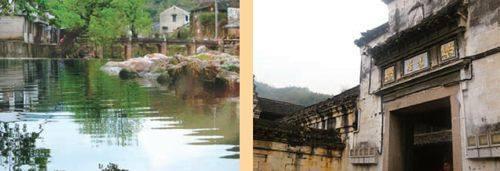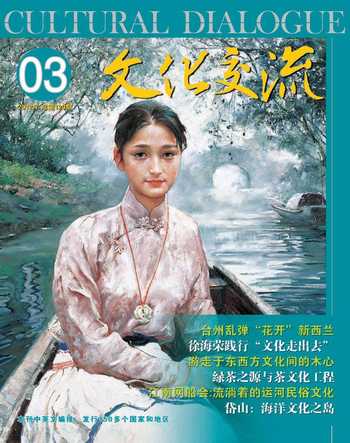魅力岩头村
2012-04-29惠泉
惠泉



穿村而过的清漾大溪 Yantou Village cradles Qingyang Stream.
岩头村为奉化市溪口镇辖地,村中文化厚积,被列为浙江省历史文化名村。人文胜迹映衬着山水风光,古韵新貌交汇,今日岩头山乡分外娇丽。人们在溪口国家5A级旅游景区休闲之后,到距离溪口11公里的岩头村,亲近自然,领略人文,徜徉于江南山水如画的美景中,自会感受不虚此行。
岩头记忆
开放的岩头,村委会办公大楼坐落在村口。楼内各组织机构健全,为民服务设施完善。岩头新貌和远景规划制作成模型,展示于一楼大厅,一目了然。
村干部毛卫海是中华毛氏联谊研究会第一届理事,他办公室里备有一本130万字的《毛氏通书》。他的介绍从贯穿全村的清漾大溪开始,“清漾”之名出自江南毛氏发祥地:浙江江山市清漾村。那里是毛泽东的祖居地,轮资排辈,岩头毛福梅和毛泽东是同辈人。清漾毛氏毛仁锵任明州太守,他的孙子毛旭,爱到奉化石门、岩头游历,其后代毛宣义钟情岩头山水。一天他从溪口策马挥鞭,一路上看远山如黛,到岩头见四周群峰围绕,中流清溪,澄澈见底,溪中有巨岩突兀,岩头地名也许由此而得。村口的白象山和狮子山由广济桥连接,桥下溪水潺潺。古人依山傍水营建村落,称许这里“环而不塞”,为藏风纳水之地。传说岩头先祖毛氏在溪流上加设三座不同的古桥,成为“毛”字的一撇二横,而弯弯清漾之水,成了“毛”字的最后一笔。在山上远眺,岩头地方形若“毛”字。清漾溪水曾孕育清一色的毛姓人家,至今已近七百年!
清漾大溪畔立有“双街古镇”石碑,以志东西两街。和古朴的东街不同,临溪的西街多现代建筑。从白象山麓起,一路上呈现幢幢新居,谈得上“村庄绿化,河道净化,卫生洁化”。老人们在店面前三五成群,闲坐聊天,安度晚年。在村落的现代建筑中,也有古宅参差其间,一两百年的古建筑,马头墙的三合院、四合院,全村有37幢!西街三份地蒋介石的原配夫人毛福梅故居依旧。她在与蒋介石立下“离婚不离家”的协议后,长住溪口,也常在岩头小住,特别是当年蒋介石在岩头读书,由毛福梅照料。
岩头人说起蒋介石与毛氏的婚姻,都知道少年蒋介石心恋岩头村姑妈的女儿,姑妈深知瑞元(蒋介石小名)生性顽劣,说是有十个女儿也不会嫁给他一个。这话传到蒋母王采玉耳里,于是,她偏偏要找个岩头村的媳妇,让亲眷看看。这媳妇就是在岩头开祥丰南货行的毛鼎和之女毛福梅。她比蒋介石年长5岁,王采玉以为有利照管在岩头读书的儿子。如今,走过鹅卵石的小径,依然可睹毛福梅住的“素居”,这是一幢晚清时的三合院建筑,二层楼房,正房和厢房有回廊相连,故居内陈列着毛福梅当年的嫁妆。她在岩头小住,携带童年蒋经国居住的卧室仍保留着。蒋经国成人后,也常对人说:“生我者溪口,养我者岩头。”
现在岩头村民勤于创业,大家还享受着村中的文化大餐,村有民俗民风馆,陈列着上百年前村中的生产、生活用具,如石磨、石捣臼、耙田的钉耙,打草鞋的草鞋耙,还有更多的老式家具。
毛邦初的故居“慰望庐”为二层楼房,粉墙青瓦,结构简洁。毛邦初从普通飞行员到抗日战争时升任空军副司令员。故居还陈列着一批毛氏后裔的爱国业迹图照。
山乡古街
从西街跨过清漾大溪,就到溪东古街,俗称东街。
20余米宽的清漾大溪,有山乡独有的神韵。不但溪名浸透着毛氏的文化渊源,而且水石相间的厚重风采天造地设。行人时而步凸出水面的石磴,时而登裸露溪中的巨岩,用双脚跨越大溪并非夸张之词,而且有多个地方可随意跨溪,并不是非走桥不可。漫步溪涧,垒垒岩石千姿百态,使人遐想翩翩,有的如野马饮水,有的如群牛休闲,也有似神龟匍匐、河马露脸。而溪水依着岩石,或从罅而出,或淙淙流泻,或深潭漫溢。潭边偶有村中少妇用棒槌捣衣,演绎着从前浣纱情景。
置身古街仿佛时光倒流,一切都是古老的,尤其是民国初年的古街,遗韵宛在。街心灵泉古井又名大井潭,印证着别处难觅的山乡旧景,当年多少过往行人、樵夫商贩直接饮用井水,泉井至今清澈鉴人,可与村口“石泉”媲美。“石泉”由清代嘉庆道光年间名震江浙的书法家毛玉佩手书。而蒋介石饮用灵泉古井水,对此也有赞语:“溪口剡溪水,雪窦飞瀑泉。要说水哪好,岩头大井潭。”
与灵泉古井相邻的毛思诚故居,为古街增加了文化气息。毛思诚是蒋介石的启蒙老师。当年他在故居开设私塾,远近闻名。少年蒋介石在别处数次求学不成,到岩头毛思诚私塾读书,依然是顽皮捣蛋,常常是课桌当舞台,凳子当刀枪。但经毛思诚的严格管束,教诲熏陶,倒能循师求学。他是蒋介石最敬重的老师。三合院的毛思诚故居是幢二层楼,小青瓦盖顶,重檐硬山埂,曾经收藏着民国十五年前的蒋介石44本日记,还有孙中山给蒋介石的一批手令、委任状、亲笔信,达180卷之多。后由毛思诚的孙子毛丁等后代捐赠给南京中国第二历史档案馆。目前书市上流行的蒋介石日记等解密史料,多出自岩头古街这个古色古香的院落。
年逾八旬的毛昭飞先生土生土长在岩头,他对古老的东街记忆犹新,说曾有2家钱庄、3家米店、3家肉店、3家中药店、4家南货店和多家杂货店。百年前岩头村不过500多户人家,山民一年吃不上几次肉,三家肉店的猪肉由谁买去?毛先生又说,在奉化山乡还没有公路的年代,大堰、万竹等乡村一批批山民,到岩头是他们的出市之地。三里小街,人头攒动,相比江南水乡周庄、乌镇、甪里,那热闹的场面另有一番山乡古风。
水乡以舟楫代步,岩头一带山民则以竹排为舟,往返于临街的清漾大溪。
位于老街一隅的灵泉古井
An ancient well in the street of Yantou Vil-lage
COUNTRYSIDE美丽乡村
如今小竹排只有在溪口的武岭头还可见到。当年竹排在岩头之多,建有排业协会,撑竹排的山民,穿行在山水之中,竹木柴炭从山里运出去,大米、棉花、药材从山外运进来,他们运载过往来客,认识山内山外各类人士。著名作家巴人(王任叔)当年就是坐竹排从大堰走出来,过岩头到宁波、上海,投身革命。
临溪而建的古老东街,两边的店铺相距只有一根扁担宽一点,却比水乡周庄不到一根扁担要宽。这里终究留下了已经远去的山乡记忆符号。民谣称:“岩头风光真正好,上有寺院下有庙,七场水碓呱呱叫,十张竹排直通萧王庙。 ”
美丽山村
人类在历史长河中展示着三大轨迹:一要温饱、二要发展、三要享受。古代的东街虽是山乡经济的归结,但从前山民生活困苦,记述岩头一带有诗:“君不见四明山下寒无粮,九月粮麦五月尝,一日辛苦无别业,日日采藤行远冈……”山民由撑竹排之苦转到当今旅游漂流的山水之乐,时而感受深潭幽深,时而在浪尖领略惊涛骇浪,漂流全过程有惊无险,融观赏山水、娱乐嬉戏和运动休闲于一体。
如今开发岩头古村旅游,风景名胜古迹众多,广济桥古树倩影,清风寺竹海栖云,石泉清幽依旧,瑞房古朴伟岸,处处有文化支撑。人们在象鼻山上的礼佛亭,可观看雪窦山的露天弥勒大佛,那坐姿佛像高56米,笑容可掬。相传奉化布袋和尚是弥勒的化身,全国有名的寺院多有弥勒佛像,旁有楹联:“大肚能容,容天下难容之事;慈颜含笑,笑世间可笑之人。 ”弥勒在奉化好事多多,对岩头似乎厚爱有加,宋代在岩头村西南有西峰寺,传说有只三脚虎,凶狠残暴,常在夜间蹿进村里吃人。弥勒知情后,赶到西峰寺岩壁边三脚虎出没处,笑嘻嘻地坐于袋口,三脚虎中计进袋,不能出来。岩壁奇怪地变成岩洞,那里曾称为布袋岩洞。过去还有弥勒诱虎塑像。如今一方安宁,成了深山移民的住处。毛伟丰一家走出世代居住的高山,住在那里安居乐业。那一排排新居,面向茂密的竹林,环境幽美。
像毛伟丰那样的下山移民,在岩头
岩头村一角 A view of Yantou Village
村集中安置的有120多户。在近20平方公里的土地上,有岩头村民892户、2400余人,现在是溪口镇上最大的行政村之一,她先后获浙江省历史文化名村、浙江省文明村、浙江省卫生村、宁波市全面小康村、宁波市民主法制示范村、宁波市生态村、宁波市农家乐特色村等荣誉称号。
岩头在前进!
建设美丽岩头,开发古村旅游,这有赖于村级领导班子,以毛卫海为代表的村干部,开拓创新,立足本村,坚持
带回字的发展理念:“走出去学经验, 42
来提水平,提上来理思路,沉下去干实事。 ”村干部组织村民延长产业链,开发旅游产品,种好奉化有名的土特产水蜜
毛福梅故居“素居”The former residence of Mao Fumei
桃、杨梅、芋艿、羊尾笋,三分之一村民护理花卉竹木。到岩头旅游,人们尝的水蜜桃似琼浆玉露,芋艿头粉糯透鲜,羊尾笋嫩白味美,使人在饱眼福之余又饱口福,归途中总是有所收获,村民的收入从中也逐年提升。
村干部积极支持村民开拓创业。如今村中有53家民营企业,各类产品销往山外,有的打响国内外市场。更多的中青年人则走出岩头,到外省外府创业,毛卫海是村民的楷模。他早年出村创业,事业有成,如今回村,是村里主要干部。他不计名利,全身心地服务村民,还鼓励儿子到外省开发矿山。村民外出有作为,财源滚滚进村来。
尊师重教传村风。从前村中下昌门有父子叔侄登科传为美谈,晚清岩头私塾有名,吸引邻里四乡子弟。过去岩头外出的人赚大钱,通过东街钱庄带到家里,信中总是千叮咛万嘱咐,要让家里孩子读好书。到外面如果懂外语,还可以创新业干大事。如今无论村内村外,都重视对后代的培养教育,“只有读好书,才能走得远”、“堂堂岩头人,学而报家国”已成为村民的理念。
美景美事美山乡,今日在建设幸福新农村的岩头人,正传承历史,开拓创新,意气风发地奔向新征途。 □
(本文图照由宁波溪口雪窦山风景名胜区管委会提供)
Yantou Village Epitomizes
Republican Years
By Hui Quan
Yantou is a scenic village in Xikou, a rural township in Fenghua in eastern Zhejiang Province. Yantou is actually a small part of the history of the Republic of China (1911-1949) as it is only 11 kilometers from Xikou, the hometown of Chiang Kai-shek (1887-1975), Chinas top leader for more than two decades before 1949 and leader of Taiwan until 1975. Chiang Kai-shek grew up in Xikou and he retired to Xikou several times during the last years of his stay on the mainland before he
fled to Taiwan in 1949. His first wife Mao Fu-mei was a resident of Yankou.
Yantou strides a stream, which is called is Qingyang Stream, named after Qingyang Village where one branch of the Mao clan originated. According to the multi-volume clan genealogy preserved at Qingyang Village in Jiangshan City in southern Zhe-jiang Province, Mao Zedongs ancestors first lived in the village before they moved northward and finally settled down at Sha-oshan in central Chinas Hunan Province. It turned out that the Mao families in Yantou are also descendents of the Mao clan of Qingyang Village. According to the clan genealogy, Mao Zedong and Chiang Kai-shek were relatives because Chiangs first wife Mao Fumei was a distant cousin of Mao Zedong, though the family ties of the political archrivals of the 20th century China were not known to the public until a few years ago. Cultural Dialogue featured
COUNTRYSIDE美丽乡村
毛思诚考取举人的官报
This government billboard an-nounces that Mao Sicheng came out as a provincial graduate in the impe-rial examination.
a story about the Mao clan genealogy of Qingyang Village in the issue of July 2008 and featured a story about Mao Zedongs grandsons visit to the family roots at Qingyang in the issue of August 2009.
Today, Yantou has 37 residence court-yards that go back at least to 100 years ago. Mao Fumeis family residence still stands. After Chiang Kai-shek divorced Mao Fumei, he made arrangements so that the ex-wife remained a member of the Chi-ang family. She lived in Chiangs home in Xikou until she died in a bombing in 1938. After Chiang and Mao got married, Chiang stayed in Yantou to study classics and his wife, senior by five years, took care of him. The son from the marriage of Chiang Kai-shek and Mao Fumei was Chiang Ching-Kuo (1909-1988), who visited and stayed at his mothers house at Yantou frequently.
At Yantou, two streets run in parallel along Qingyang Stream. The stream is about 20 meters across at the widest spot. In some places, stepping stones are used for villagers to walk across the stream. Boul-ders in the stream take various shapes, set-ting some peoples imagination free.
The two streets were built in the early years of the Republic. There is a well in the street where passers-by drank in the past. At the entrance to the village stands a rock with an inscription by Mao Yupei, a master calligrapher of the Qing Dynasty (1644-1911), who enjoyed a big reputation in Zhe-jiang and Jiangsu provinces. Chiang Kai-shek once wrote a short poem in praise of the water.
The former residence of Mao Sicheng is a cultural monument of Yantou. Mao Sicheng was Chiang Kai-sheks first teacher, who ran a private school at home. A naughty boy, Chiang Kai-shek in his boyhood years was turned down by some schools close to his hometown Xikou. He finally came to the school of Mao Sicheng, 11 kilometers away from his home. Of all the teachers Chiang had in his lifetime, Mao Sicheng was most respected by Chiang. Chiang Kai-shek later gave his teacher 44 volumes of his diary he wrote before 1926 and other documents in his personal archive such as notes, let-ters of appointments, and letters from Dr. Sun Yat-sen. All together, the archive at the residence had 188 historical volumes. In 1966, the precious files were in the danger of being torched. The files were saved and later returned to the care of Mao Ding, the grandson of Mao Sicheng. The 188 volumes have been donated to the Number Two Na-tional Archives in Nanjing. The diaries and other documents have been the sources of many books on Chiang Kai-shek published on the mainland.
Yantou used to be a marketplace for vil-lages deep in mountains inaccessible by wide roads. In the past, the village boasted two banks, three rice shops, three butchers shops, three herbal medicine shops, four southern delicacies shops, and some gro-cery shops to cater to the customers from mountain villages. At that time, Yantou had 240 households and villagers ate meat only a few times around the year. What makes the shops look unique and homey is that the main street on the east side of the stream is only about two meters wide.
In those years, bamboo rafts were most convenient means of transport in Yantou. Nowadays, bamboo rafts can only be seen at one place around Xikou. Yantou used to have a rafters guild. They shipped bamboos, firewood, charcoals out of mountains and shipped rice, cotton and herbal medicines into the mountains. Nowadays, rafts are used for pleasure tours on the stream. It is a big attraction for tourists.
Yantou is no longer a trade center as it was a century ago. Yantou has turned itself into a tourist attraction. From a pa-vilion near the village, tourists can see the 56-meter-tall statue of Maitreya in Xuedou Mountain at Xikou. Yantou is now the larg-est administrative village in Xikou with 592 households, a population of 2,400. Village economy is flourishing. In addition to tourism, it is home to 53 private businesses. Many young people go outside to do business. Some run their enterprises overseas. Educa-tion is still a big tradition of Yantou. □=
